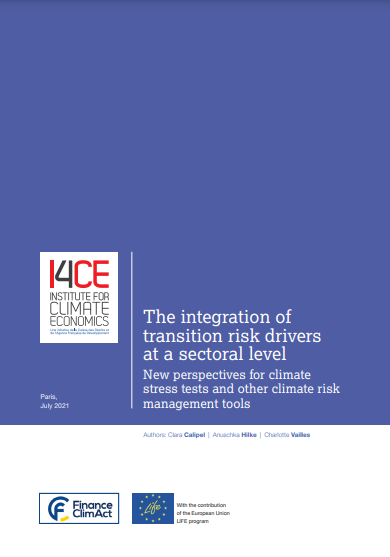Climate stress tests: The integration of transition risk drivers at a sectoral level
Since 2018, and under the initiative of the NGFS, the network of central banks and supervisors for greening the financial system, several central banks and supervisors have begun to conduct their first climate stress test exercises to determine the vulnerability of financial institutions to climate-related risks. In order to help central banks to carry out this type of exercise, the NGFS published in 2020, its first guide to climate scenarios analysis that can be used in climate stress tests.
In its report, I4CE attempts to provide new reflexions to the analysis of climate scenarios that can be used in climate stress tests, by providing a more detailed sectoral approach than that the one proposed by the NGFS. In particular, this study demonstrates the importance of an intra-sectoral analysis in order to identify the risks drivers specific to each sector and the vulnerability indicators specific to each actor of the sector.
The report is based on two sectoral case studies, one focusing on the private residential property sector and the other on the cement industry in France.
There are many transition risk drivers, which differ according to the sector and can overlap
For the two case studies, a detailed analysis of these two sectors and of their specific transition issues has identified several transition risk drivers for each sector.
In each case, the analysis of these risk drivers has demonstrated the plausibility of their overlapping. If they emerge simultaneously, the effects of these risk drivers could be multiplied, thereby increasing the final risks.
Click on this button to see the image
Not all actors within a given sector have the same capacity to deal with transition risks
The report also shows that an intra-sectoral analysis is essential to assess the difference in vulnerability of the economic actors (households and companies) to the different risk drivers.
The analysis of the vulnerability indicators is also necessary to determine the extent to which the overlapping of these risk drivers could multiply the impacts, since the number of counterparties potentially concerned increases.
A quantification of the different sectoral risk drivers through the vulnerability indicators would be a next step. It would help to determine the orders of magnitude for each risk driver, and thus demonstrate the relevance of assessing risk drivers at intra-sectoral levels.
In addition to stress tests, analyses of risk drivers would improve other risk management tools
The research could also potentially provide valuable insights to improve the transition risk management tools used by financial institutions, thanks to in-depth understandings of transition risks at the sub-sectoral levels.
Finance ClimAct project
This study is part of the Finance ClimAct project and was carried out with the contribution of the European Union LIFE program. This Work reflects only the views of I4CE. Other members of the Finance ClimAct Consortium, as well as the European Commission, are not responsible for any use that may be made of the information it contains.
![]()

With the contribution of the European Union LIFE program
What is a climate stress test? Why is the sectoral view important in such an exercise? Clara Calipel answers these questions and summarizes in 2 minutes the main results of her study on the integration of risk factors at the sectoral level :


